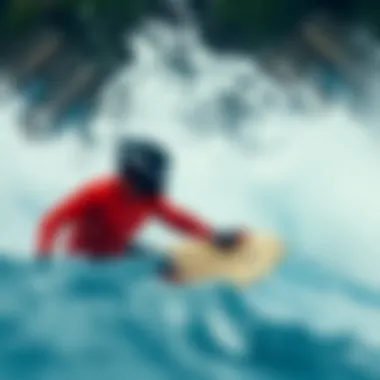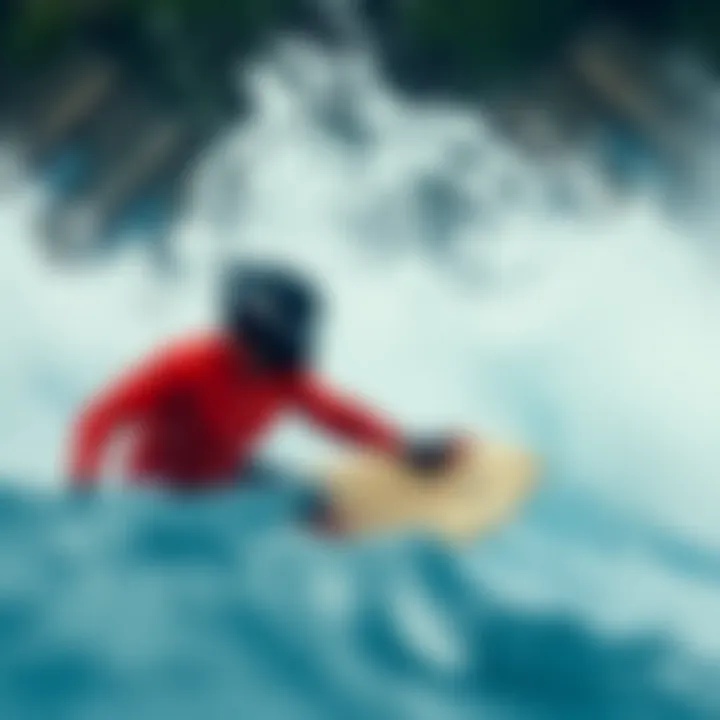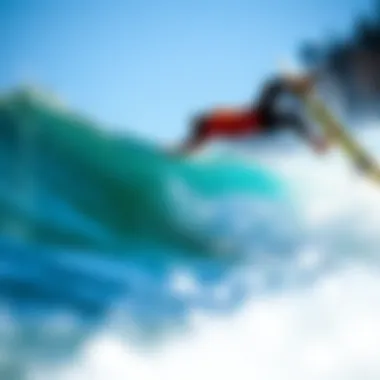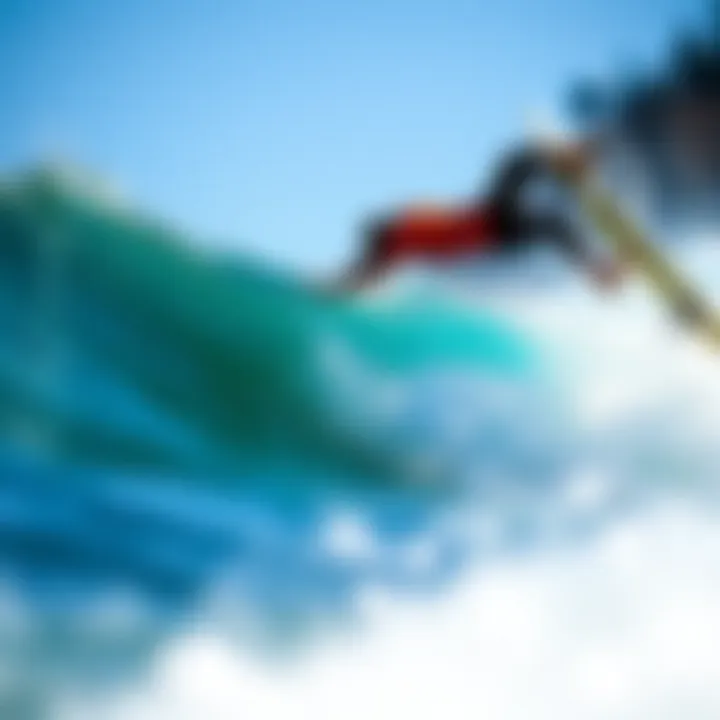Adrenaline-Packed Water Extreme Sports Adventures


Intro
The allure of water extreme sports is undeniable. From roaring waves to calm lakes, each body of water beckons adventurers, offering thrilling escapades that push limits and test skills. Whether you’re skimming the surface on a surfboard or diving into the depths while exploring vibrant coral reefs, these sports offer an exhilarating connection with nature.
In this article, we’ll navigate the multifaceted world of water sports, shining a light on various disciplines, essential equipment, and techniques needed to take part. We’ll unravel the specifics of surfing, windsurfing, kitesurfing, wakeboarding, and scuba diving, providing a comprehensive understanding for both novices and seasoned enthusiasts alike. By the end, readers will appreciate not just the exhilarating aspects but also the cultural significance and the environmental impact of these activities.
Surfing Techniques
Surfing is often seen as the quintessential water sport, known for its graceful movements and adrenaline rush. To excel, it’s essential to master fundamental techniques, and then build upon them.
Advanced Maneuvers for Experienced Surfers
Once you can ride the waves with confidence, the horizon opens up to numerous advanced techniques that can elevate your performance. Here are some key maneuvers:
- Cutback: This involves turning back towards the breaking wave after reaching the shoulder. It keeps your momentum alive while maximizing wave energy.
- Aerials: Getting airborne off the lip of a wave adds flair to your performance. The key is timing your take-off and knowing your landing to stay on your board.
- Bottom Turn: The bottom turn sets the pace for your ride, allowing for smooth transitions. It's pivotal in generating speed as you prepare for the next move.
Each of these maneuvers requires practice and the right conditions. Finding the right waves is as crucial as having the right technique.
Beginner Tips for Catching Your First Wave
Catching your first wave can be a daunting adventure, but fear not. Here are some tips to ease into the experience:
- Choose the Right Wave: Look for smaller, gentle waves. They’re perfect for beginners, allowing you to focus on balance and technique without overwhelming force.
- Position Yourself Correctly: Make sure to sit on your board in the right place. Ideally, you should be positioned at the center, with the nose slightly pointed towards the shore.
- Paddle Like You Mean It: As the wave approaches, paddle hard to get into the right spot. Timing is everything; you want to feel the wave lift you.
- Stand Up Smoothly: When you feel the wave pick you up, pop to your feet swiftly but smoothly, keeping your knees bent and your weight centered.
These initial rides can ignite a passion for the sport, leading you to conquer larger waves over time.
Gear and Equipment Reviews
The right equipment is paramount in ensuring a safe and enjoyable experience. Below, we'll delve into some of the must-have items every surfer should consider.
In-Depth Review of the Latest Surfboards
There are countless surfboard shapes and designs tailored to various styles and water conditions. Key factors to consider include:
- Material: Modern boards come in various materials, including foam, fiberglass, and epoxy, each offering its own benefits in buoyancy and durability.
- Shape and Size: The dimensions of the board affect performance. Shortboards are great for advanced maneuvers, while longboards provide stability and ease for beginners.
- Brand Review: Consider boards from well-known brands like Channel Islands, Firewire, and Lost, which have been vetted by expert surfers.
Essential Accessories Every Surfer Should Have
Beyond surfboards, certain accessories enhance the surfing experience:
- Wetsuit: A good wetsuit provides insulation against chilly waters. Choose thickness based on your local water temperature.
- Leash: This keeps your board attached to you, preventing it from drifting away. Safety is key, so don’t skimp on quality.
- Wax: Applying wax to your board enhances grip, helping you stay upright. It’s a minor detail that makes a big impact.
The right gear can make or break your experience, ensuring safety while exploring the excitement of water sports.
"The ocean stirs the heart, inspires the imagination, and brings eternal joy to the soul."
Preamble to Water Extreme Sports
Water extreme sports are not merely recreational activities; they embody a profound interaction between nature and human endeavor. These sports, which include surfing, windsurfing, kitesurfing, wakeboarding, and scuba diving, thrive on adrenaline and skill, appealing to those who seek adventure and challenge. The realm of water extreme sports is as expansive as the oceans themselves, inviting enthusiasts from all walks of life to engage with powerful currents and untamed waves.
Participating in water extreme sports offers numerous benefits. Firstly, they foster a unique connection with the environment. Being in the water, under the sun, and feeling the wind against one's skin can invigorate the senses and restore a feeling of freedom. Additionally, these sports can also be highly beneficial for physical health. They improve cardiovascular fitness, flexibility, and strength, creating a holistic engagement of the body and mind.
However, venturing into these activities does come with its own set of considerations. Safety is paramount; understanding how to navigate currents, proper equipment usage, and knowing one’s limits are essential for a fulfilling experience. Moreover, the environmental impact of these sports on aquatic ecosystems must not be overlooked. Enthusiasts are encouraged to adopt sustainable practices that respect marine life and their habitats.
In summary, the exploration of water extreme sports is a fascinating journey through skill, thrill, and understanding. It stands as a testament to human resilience and our intrinsic desire to conquer the elements. As we delve deeper into specific activities, we shall uncover the nuances, skills, and cultures that shape this vibrant community.
Surfing: The Art of Riding Waves
Surfing is not just a sport; it’s an embodiment of freedom and a connection with the ocean. The waves, the board, and the surfer create a dance that’s as thrilling as it is beautiful. Understanding this art form provides insight into not only the skill involved but also the culture and lifestyle that surrounds it. This section dives deep into the heart of surfing, offering essential knowledge that can enhance the experience for both enthusiasts and onlookers alike.
History and Evolution of Surfing
Surfing can trace its roots back to ancient Polynesian culture, where it was known as "he'e nalu." Historically, surfing was more than just recreation; it had spiritual significance and was often linked to status among the islanders. As time progressed, the practice spread to Hawaii, California, and beyond, evolving into the modern sport we recognize today. Key developments, like the transition from heavy wooden boards to lightweight surfboards, transformed surfing into a more accessible and diverse activity.
Popular Surfing Techniques
Surfing isn’t just about paddling out and trying to catch waves; it involves several techniques that can make or break your ride. Here are three cornerstone techniques every surfer should understand.
Paddle Techniques
Paddle techniques are vital for getting into position to catch waves. Surfers commonly use a prone position to paddle for a wave, leveraging their upper body strength. This technique is beneficial because it allows surfers to maximize their speed and positioning on moving water. A unique feature of paddle techniques is that a good paddler can catch waves others may miss, shifting the dynamics of competitive surfing. However, overexertion can lead to fatigue, which is a disadvantage if one doesn't pace themselves while paddling or fails to maintain momentum.
Wave Selection
Wave selection is essential for surfers aiming to ride quality waves. Choosing the right wave can significantly enhance a surfer’s experience. A key characteristic of good wave selection involves assessing wave shape, size, and the presence of a rip current. This choice is beneficial because it directly affects the ride experience; the right wave can lead to a thrilling ride while a poor selection might result in wiping out. However, waiting too long for the perfect wave can lead to missed opportunities and frustration, which is a common pitfall in the sport.


Turning Mechanisms
Turning mechanisms are what grant surfers the ability to maneuver on waves. Learning to carve turns is crucial for maintaining speed and control. By shifting their weight and adjusting body positioning, surfers create smooth transitions. This technique is popular because it helps surfers adapt to changing wave conditions, allowing for creativity in their rides. The downside, perhaps, is that improper turns can lead to loss of speed or balance, especially for beginner surfers who might struggle with timing.
Understanding Surfboards
The type of surfboard a surfer rides plays a major role in their surfing experience. It affects everything from speed to maneuverability, and understanding the various types can greatly improve performance.
Types of Surfboards
Different styles of surfboards cater to different surfing conditions and skill levels. From shortboards for quick maneuvers to longboards for stability and ease, each type serves a unique purpose. Choosing the right board can significantly benefit a surfer's performance, as specific boards excel in varied wave conditions. The downside of specialized boards is that they may not be suitable for all conditions. A novice might find a performance shortboard challenging, limiting their learning curve in varied scenarios.
Materials Used
Surfboards are constructed from various materials, prominently polyurethane foam and fiberglass. High-performance boards often incorporate epoxy resins for increased durability and reduced weight. This unique feature enhances surface response, leading to improved performance. However, the more advanced materials can drive up costs, which might deter some potential surfers from investing in higher-quality boards.
Maintenance Tips
Proper maintenance of surfboards is crucial for longevity and performance. Rinsing the board after every use helps to remove saltwater and sand, which can wear down the surface over time. Another key aspect includes regular inspections for dings and repairs, which can save a surfer money in the long term. While maintenance might feel tedious, it’s an essential aspect that directly influences a board’s performance. Neglect can lead to costly repairs later, or worse, a damaged board during a surf session, which can ruin an outing.
Investing time in understanding surfing can lead to greater enjoyment and mastery of this dynamic sport. Whether you're a beginner or a seasoned surfer, there’s always something new to learn from the ocean.
Windsurfing: Harnessing Wind and Water
Windsurfing blends the thrill of surfing with the harnessing of wind. This sport stands out in the realm of water extreme sports due to its unique combination of skills involving both sailing and surfing techniques. For enthusiasts and newcomers alike, understanding windsurfing is crucial because it opens a door to adventures that offer both adrenaline and tranquility. It's not just a method of travel across water; it's a dance with the forces of nature, a deft balancing act that ignites passion and excitement.
Fundamentals of Windsurfing
Windsurfing relies on a simple yet sophisticated rig that allows riders to glide seamlessly across the water. At its core, it uses a board paired with a sail to catch the wind and propel the rider. Understanding its fundamentals is pivotal for anyone keen on taking up this sport. Unlike traditional sailing, which involves larger boats, windsurfing offers a more personal and exhilarating experience, letting individuals navigate through waves and winds with agility.
The primary components of windsurfing are the board, sail, mast, and boom. Each piece plays a vital role. The board, shaped for buoyancy and control, is where the rider stands. The sail's size and material significantly influence performance, serving as the primary driving force. Moreover, mastering the basic techniques of windsurfing quickly leads to improved skills and heightened joy on the water.
Techniques for Mastery
Sailing Techniques
Sailing techniques form the backbone of a windsurfer's experience. Effective sailing relies on understanding wind direction, sail trim, and balance. A key characteristic of these techniques is their adaptability; a skilled windsurfer can adjust to varying conditions, whether the winds are light or gusty. For instance, in light winds, maintaining the sail's angle becomes crucial as this can maximize momentum. The beauty of mastering these techniques lies in the feeling of flying across the water, merging human skill with nature's power.
However, each sailing technique has its challenges. For example, beginners may struggle with balance, often finding themselves tumbling into the water. Yet, with consistent practice, those hiccups become mere stepping stones toward greater accomplishments in this sport.
Tack and Jibe Maneuvers
Tack and jibe maneuvers are essential for any windsurfer wanting to navigate effectively. Tack involves turning the board into the wind to change direction, while jibe allows for smooth transitions downwind. These maneuvers are critical because they enable the windsurfer to ride continuously without losing speed or control. The main advantage of mastering these techniques is the ability to remain agile and responsive to changing wind conditions.
The unique feature of tack and jibe is their requirement for practice and precision. Learning these maneuvers can be tricky initially but ultimately adds excitement to the experience. They're a significant leap into advanced windsurfing and essential for any rider wanting to excel, providing a sense of accomplishment when executed flawlessly.
Essential Gear Overview
Part of what makes windsurfing successful is the right equipment. Understanding the essential gear can elevate one's performance significantly.
Sails
Sails come in various sizes and shapes, designed to fit different wind conditions and riding styles. Selecting the right sail is paramount for performance. A larger sail offers more power in lighter winds, while a smaller sail might be favored in high winds for better control. The importance of sail choice can't be overstated, as it directly ties into safety and efficiency on the water.
Unique to sails is their construction material, often made of durable fabrics that withstand wear and tear. However, heavier sails may be challenging for beginners, who may benefit from lighter options that allow for more accessible handling and maneuverability.
Boards
Windsurfing boards vary greatly, designed for different skill levels and types of riding. Freestyle boards, for example, are smaller and used for tricks, while freeride boards provide stability for cruising. The choice of board impacts speed and maneuverability, which can significantly affect the overall experience.
One unique aspect of boards is their adaptability to a rider’s growth. An individual may start with a beginner-friendly board but later transition to one that enhances performance as their skills develop. This flexibility is a significant advantage that keeps the sport exciting.
Safety Equipment
Safety equipment, such as harnesses, helmets, and flotation devices, is critical in windsurfing. Using a harness enables a windsurfer to leverage their body weight effectively against the sail, allowing for longer rides without fatigue. A helmet protects against potential accidents, while flotation devices provide added safety, ensuring a rider remains buoyant should they fall.
The distinctive feature of safety equipment is its ability to provide peace of mind, allowing riders to focus on their performance. Not having the right safety gear can lead to serious accidents, so emphasizing its importance cannot be overstated. Proper equipment ensures that the thrills of windsurfing do not come at an unnecessarily high risk.
Safety is not just a precaution; it’s a mindset—essential for truly enjoying your windsurfing adventure.
By understanding the nuances of windsurfing, enthusiasts can navigate not just waters but their own capabilities, all while partaking in exhilarating experiences. Each technique and equipment choice contributes to riding the winds and water with finesse, making windsurfing a truly captivating sport.
Kitesurfing: The Fusion of Surfing and Paragliding
Kitesurfing blends the thrill of surfing with the exhilaration of paragliding, creating a unique water sport that has captivated many adventurers. This discipline stands out in water sports due to its dynamic nature and the sheer fun of harnessing the wind while skimming across a body of water. The importance of kitesurfing in extreme sports lies not only in the excitement it offers but also in the skill and agility required to navigate varying conditions.
Kitesurfing Mechanics


Kitesurfing is essentially controlled chaos, where skillful maneuvering is paramount. It demands understanding the kite's behavior in different wind conditions and how these affect your ride. Riders use a board tethered to a large, inflatable kite. The kite acts as the engine, capturing the wind’s energy and propelling the rider over the water. This unique setup means that riders must balance their weight and control the power of the kite simultaneously. If you haven’t yet tried kitesurfing, be prepared: it’s as much about feeling the wind as it is about technical skills.
Key Techniques for Beginners
Launching a Kite
Launching a kite correctly is fundamental for kitesurfing. It’s the first step in getting out onto the water, and doing it safely is absolutely crucial. Proper launching involves managing the wind and ensuring that your lines are untangled. Beginners are often taught to launch with an assistant first, ensuring everything goes smoothly. A key characteristic of launching is recognizing the power zone: it’s where the kite generates maximum pull. Mastering this technique is not only a beneficial choice for safety but a cornerstone for progression in the sport.
Board Control
Board control refers to the rider’s ability to manage their movements on the water while connected to the kite. It includes balancing on the board and adjusting your position for optimal performance. One of the unique features of board control is the ability to shift your body weight to maneuver and carve through the water. This active engagement creates a rewarding feeling of mastery and skill. However, achieving solid board control takes time and practice influenced by the rider’s responsiveness to the kite’s pull.
Tricks and Maneuvers
As you become more comfortable, tricks and maneuvers become enticing. They add a thrilling dimension to kitesurfing. Beginners often start with simple jumps and turns, progressing to more complex tricks like grabs and spins. What makes tricks particularly appealing is the combination of style and technique required to execute them properly. Each trick has its own set of challenges, providing a constant opportunity to improve and innovate. The flips and spins impress audiences but also encourage personal growth and confidence on the water.
Safety Protocols in Kitesurfing
Safety is a top priority in kitesurfing, given the power of the wind and the equipment involved. It's essential for kitesurfers to understand and adhere to various safety protocols. This includes checking gear before hitting the water, knowing the local conditions, and ensuring that rescue options are always available. Here are some basic protocols to consider:
- Pre-flight checks: Always inspect your kite, lines, and harness for any signs of wear or damage.
- Understanding the wind: Different wind conditions require different approaches. Beginners should avoid strong winds until they gain experience.
- Using safety equipment: Wearing a helmet and a personal flotation device can save lives.
Wakeboarding: Boarding on Water
Wakeboarding has earned its place as a prominent facet of the water extreme sports arena, standing as a testament to the thrill-seeking spirit of enthusiasts everywhere. Increasingly popular in recent years, wakeboarding combines elements of surfing, snowboarding, and water skiing, providing an exhilarating experience that draws individuals from various backgrounds. The importance of wakeboarding lies not only in the rush it delivers but also in the unique skills and community it fosters.
Many wakeboarders find joy in performing tricks and showcasing their prowess on the water, which creates a lively and engaging culture. Furthermore, the sport encourages physical fitness and camaraderie among participants, making it a social activity as much as a competitive one. As we delve into different aspects of wakeboarding, we will uncover its evolution, the exciting techniques that define it, and considerations for choosing the right equipment.
The Evolution of Wakeboarding
Historically, wakeboarding emerged in the 1980s as a hybrid between water skiing and snowboarding. Riders began to attach themselves to a single board, which allowed for greater freedom of movement. By the late 1990s, the sport underwent rapid development with the introduction of innovative boards, bindings, and techniques.
Over time, wakeboarding has evolved into a competitive sport, with professional events hosted globally. This growth has led to increased recognition, making wakeboarding accessible to a wider audience. Key to this evolution is the development of equipment that promotes safety and performance, thus enhancing the overall experience. With advancements in technology, newer boards and bindings are designed to cater to various skill levels, welcoming newcomers while pushing the limits for seasoned riders.
Techniques and Tricks
Mastering wakeboarding requires a comprehensive understanding of its techniques and tricks. Aspiring wakeboarders can progress through different skill levels, granting them opportunities to showcase impressive maneuvers. Let's break down two key aspects:
Jumping Techniques
Jumping is a hallmark of wakeboarding, and it encapsulates the thrill of soaring above the water's surface. The ability to perform jumps allows riders to express creativity and skill, thus contributing to the excitement of the sport.
The key characteristic of jumping techniques lies in the timing and momentum gained from the wake of the boat. As riders approach the wake, they must shift their weight correctly while leaning back to achieve optimal lift. This technique is popular because it not only demonstrates control but also opens doors to various aerial tricks.
Some advantages of jumping techniques include enhancing an athlete's skillset and fulfilling the deep-seated desire for adrenaline-pumping experiences. However, it does come with its challenges, including the risk of falls. Proper safety measures and training, therefore, remain essential for all aspiring jumpers.
Grabs and Spins
Another exciting aspect of wakeboarding is the execution of grabs and spins, which add flair and personal style to a rider's performance. Grabbing the board mid-air creates a unique signature that distinguishes riders in a competition setting.
The appeal of grabs and spins lies in their ability to showcase a rider's individual creativity while delivering an element of surprise to the audience. This characteristic makes them a favored choice among competitors and recreational wakeboarders alike.
A unique feature of grabs involves the various hand placements on the board, each providing a different aesthetic and level of difficulty. Spins, on the other hand, challenge riders to balance speed, direction, and form. While they can be risky, properly executed spins can impress judges and elevate a rider's standing in competitions.
Choosing the Right Board
Selecting the appropriate wakeboard is crucial for achieving comfort and performance on the water. Riders should consider several factors when choosing their gear. Here are essential aspects to look into:
- Skill Level: Beginners may prefer wider boards for stability, while advanced riders might opt for narrower boards to facilitate tricks.
- Board Shape: The choice of shape affects how the board rides on the water. A continuous rocker offers smooth rides, while a three-stage rocker enhances jumps.
- Bindings: The right bindings ensure comfort and secure attachment for maximum control. It’s vital to find bindings that fit snugly without causing discomfort.
Ultimately, the chosen board can significantly impact one’s experience and ability to progress in wakeboarding. Balancing personal preferences with performance features will help riders not only enjoy wakeboarding but also enhance their skills.
The world of wakeboarding is as vibrant as the water where it occurs, full of energy, camaraderie, and endless opportunities for growth and excitement. Embracing this sport involves much more than simply strapping on a board; it's about joining a community that thrives on adventure and pushes boundaries.
Scuba Diving: Exploring Underwater Worlds
Scuba diving is not just a sport; it’s an opportunity to step into an entirely different realm. This underwater adventure opens up a world teeming with awe-inspiring marine life, vibrant ecosystems, and the thrill of exploring hidden underwater landscapes. Its significance in the realm of water extreme sports cannot be overstated. Whether it’s the lure of discovering ancient shipwrecks or simply immersing oneself in the tranquility of the ocean’s depths, scuba diving offers both adventure and serenity. It's a blend of physical challenge and meditative exploration that captures the hearts of many enthusiasts around the globe.
Diving Basics and Training
Before suiting up for an underwater excursion, understanding the basics of scuba diving is crucial. Training is not just recommended; it’s essential. Programs, such as those offered by PADI (Professional Association of Dive Instructors) or SSI (Scuba Schools International), provide the foundational knowledge necessary for every diver. These courses cover everything from understanding pressure effects to mastering buoyancy control and underwater navigation. It’s all about becoming familiar with your equipment and environmental awareness. Learning the ropes ensures safety and enhances the overall experience.
Essential Diving Equipment
Having the right gear is pivotal in scuba diving. It’s the difference between a memorable dive and a perilous adventure. Let’s break down some key components:


Diving Suits
Diving suits are essential for both thermal protection and safety. Most divers will opt for wetsuits or drysuits depending on the water temperature. Wetsuits are good for milder climates, allowing water to enter and warm against the skin. In contrast, drysuits provide insulation by keeping water out entirely, making them ideal for colder conditions. A wetsuit's flexibility is a key advantage as it allows for a greater range of motion. However, they may not be as effective in extreme cold conditions, which makes drysuits a better option for deeper dives or colder underwater environments, although they can be trickier to use effectively, especially for beginners.
Regulators
Regulators are the lifeline of the diving world. They enable divers to breathe underwater by reducing the high-pressure air from the tank to breathable pressure. The most common types are first-stage regulators, which connect directly to the air tank, and second-stage regulators, which you place in your mouth. A vital feature is a second stage that includes a purge valve to clear water effectively. Choosing a reliable regulator can make or break the diving experience. Some divers may turn to brands like Scubapro or Aqualung, recognized for quality and performance, but personal preference often drives choices here. It's worth noting that regulators can be pricey, but ensuring functionality and comfort should be a foremost priority.
Buoyancy Control Devices
Buoyancy Control Devices (BCD) allow divers to achieve neutral buoyancy, helping them control ascent and descent. This control is not just paramount for comfort but key to safety as well. A good BCD provides both stability and comfort during a dive. Most BCDs come with pockets for additional weights and gear, making them quite versatile. The inflatable bladder is unique because it allows you to adjust buoyancy while under the water. However, the bulk of some models can be cumbersome, particularly for beginners. Diving schools often recommend models suited for entry-level divers, which balance functionality and ease.
Safety Considerations for Divers
When venturing into the depths, safety cannot be overstated. It encompasses everything from understanding dive tables and monitoring air supply to knowing emergency protocols. One crucial aspect is the buddy system: diving with a companion significantly enhances safety. Everyone should be familiar with basic rescue techniques and when to surface to avoid decompression sickness. Furthermore, divers should ensure their physical fitness is up to par for safe diving practices.
In summary, exploring the underwater worlds through scuba diving allows enthusiasts to engage with nature in a way few can experience. With proper training, equipment, and safety knowledge, divers can embark on countless adventures while appreciating the beauty and complexities of marine ecosystems. Diving logbooks, sharing experiences through platforms like Reddit or Facebook, can foster community interaction and support among divers. More information can be gleaned from educational websites like en.wikipedia.org or britannica.com that delve deeper into the science and thrill of scuba diving.
Environmental Considerations in Water Sports
Water extreme sports not only provide a thrilling escape from the mundane but also connect participants to the very nature that shapes these adventures. As such, the environmental considerations in water sports are paramount. With increasing participation rates, understanding how these activities impact marine ecosystems becomes critical for enthusiasts and stakeholders alike. The delicate balance of nature must be respected and preserved to ensure that future generations can also revel in the wonders of the water.
Impact on Marine Ecosystems
The boom in water sports has undeniably left its mark on marine ecosystems. Consider this:
- Habitat Disruption: Activities like jet skiing and wakeboarding can cause significant turbulence, disturbing the habitats where aquatic life thrives. The noise and waves generated can terrify marine animals, disrupting their breeding and feeding patterns.
- Pollution: The use of boats and watercraft often leads to fuel spills and waste disposal that contaminate local waters. Chemical pollutants can harm water quality, affecting the fish and plants that rely on a healthy environment.
- Invasive Species: The transport of equipment and watercraft from one body of water to another can inadvertently introduce invasive species, putting native populations at risk. For instance, a simple hitch in a boat launch might bring along unwelcome hitchhikers, wreaking havoc in a fragile ecosystem.
"Our passion for water sports should drive us toward stewardship, not devastation. Preserving marine ecosystems is not just a duty; it's a responsibility we owe to the waters that nurture our adventures."
While the impact can seem daunting, there's hope. Many organizations and groups are working tirelessly to address these concerns and promote awareness about the environmental effects of water sports. It’s crucial for participants to stay educated and informed about the ecosystems they engage with.
Sustainable Practices for Enthusiasts
Embracing water sports comes hand in hand with a commitment to sustainability. Here are some practices that enthusiasts can adopt:
- Choose Eco-friendly Gear: Seek out boards, kayaks, and other equipment made from sustainable materials. Brands are increasingly recognizing their responsibility to the environment, and opting for eco-conscious products can make a difference.
- Practice Leave No Trace: This age-old principle applies just as much to water as it does to land. Whatever gear or materials you bring along, make sure to pack them out. Dispose of waste properly and leave nature just as you found it.
- Support Clean-up Initiatives: Get involved with local groups that focus on cleaning up aquatic areas. It's a chance to give back and enhance the environments you enjoy.
- Educate Yourself and Others: Stay informed about the local ecosystems and engage others in conversations about sustainability. Share knowledge, volunteer for workshops, or participate in educational programs that elevate awareness on environmental issues related to water sports.
In summary, as excitement for water extreme sports grows, so does the need for environmental consciousness. By embracing responsible practices, participants can enjoy the thrill while ensuring that the waters they love remain vibrant for years to come. Remember, the ocean is not just a playground; it's a sanctuary that deserves care and respect.
For further reading on environmental impacts and sustainability practices, check out resources from the National Oceanic and Atmospheric Administration and organizations like the Surfrider Foundation.
Engaging in water sports should spark a passion—not just for the thrill but also for preserving the beauty beneath the surface.
Community and Culture of Water Sports
Water sports encapsulate more than just thrilling activities; they forge a strong sense of community among enthusiasts across the globe. This sense of belonging is vital as it fosters shared experiences and promotes camaraderie among diverse individuals who share a common passion.
The Global Water Sports Community
The global water sports community is a melting pot of cultures and backgrounds, drawing people from every corner of the world. It is not just about the adrenaline rush of a perfect wave or the thrill of diving deep into the ocean. It’s about building lasting friendships, exchanging knowledge, and supporting one another in each discipline. Whether it’s through local groups, online forums such as reddit.com or social media connections on platforms like Facebook, enthusiasts connect over their love for sports like surfing, windsurfing, kitesurfing, and scuba diving.
The bonds formed go beyond the sport itself; they often lead to collaborations on environmental initiatives that protect marine life and habitats. For instance, many surfing communities engage in beach clean-ups, facing off against pollution and advocating sustainability within their regions. These efforts not only help protect the environment but also reinforce community strength, inspiring more enthusiasts to join the cause and learn about the ecological impact of their hobbies.
Events and Competitions
Events and competitions play a significant role in promoting the sense of community among water sports enthusiasts. They serve as gathering points where athletes can showcase their skills, celebrate their passion, and connect with like-minded individuals.
International Competitions
International competitions are the ultimate stage for athletes striving to test their mettle against top competitors worldwide. Events like the World Surf League and the Red Bull Cliff Diving World Series draw attention not only for the sports but also for the culture they embody. At these gatherings, athletes from diverse backgrounds come together, all aiming for excellence and to foster goodwill among nations.
A key characteristic of these international competitions is their ability to elevate local sports into globally recognized events, attracting sponsorships and media coverage. This enhanced visibility benefits athletes looking to make a name for themselves, while also encouraging tourism and stimulating local economies. The unique feature of these events often includes a blend of professional-level competition and opportunities for amateur participants, creating a rich environment full of learning and personal growth. However, as beneficial as these competitions are, they can impose a heavy financial burden on lesser-known athletes, creating barriers to entry that some might find discouraging.
Local Events
Conversely, local events are the heart and soul of the water sports community, often reflecting the spirit and culture of a region. These gatherings are typically organized by local clubs or communities, allowing even novices to participate and enjoy the thrill of competition without the high stakes involved in international events.
A notable aspect of local events is their inclusivity; they welcome participants of all skill levels, offering a supportive atmosphere that encourages newcomers to engage with the sport. Local competitions often showcase regional flavors, embodying the local culture through music, food, and other traditional elements. This unique feature fosters pride and promotes community cohesion, but they can be less organized or lack the exposure that larger competitions receive, potentially limiting their growth and reach.
In summary, both international and local events are essential for nurturing the community of water sports, each contributing in its own way to the vibrancy and richness of the culture as a whole.
Finale
As we navigate through various thrilling avenues of water extreme sports, it's critical to take a step back and understand the broader significance of these activities. The conclusion isn't merely an end; it's a lens through which we can look at future developments, challenges, and opportunities in the realm of water sports.
The Future of Water Extreme Sports
Looking ahead, the future of water extreme sports seems to have a tide of possibilities that only continue to swell. With technological advancements and a growing awareness of environmental sustainability, the next generation of water sports enthusiasts is bound to redefine what it means to engage in these activities.
- Technological Innovations: Equipment continues to evolve. From smart wetsuits that regulate body temperature to kitesurfing gear that improves aerodynamics, the integration of technology can enhance performance while ensuring safety. The embrace of augmented reality could soon offer immersive experiences for participants, allowing for instant feedback and skill development.
- Sustainability Initiatives: As awareness surrounding environmental issues grows, many sports communities are adopting sustainable practices. For instance, initiatives aimed at reducing plastic waste and preserving marine habitats are gaining traction. Emphasizing eco-friendliness will be paramount in ensuring that future generations can enjoy our oceans and lakes as we do today.
- Global Inclusivity: The water sports community is becoming more inclusive. Open events are making it easier for individuals from diverse backgrounds to participate, ensuring that everyone can experience the adrenaline rush without barriers. This is vital in fostering a vibrant culture where sharing knowledge and skills bridges gaps.
- Emerging Sports: With the rise of hybrid forms of water activities, we may see new disciplines emerge that blend elements from existing sports. Innovations often come from creative samplings – who knows what new kind of thrill awaits?
In summary, the conclusion of our exploration reveals that water extreme sports will not only endure but will also thrive as they adapt to changing societal norms and environmental imperatives. The synergy between tradition and innovation holds boundless potential for exhilarating adventures that beckon enthusiasts worldwide.















